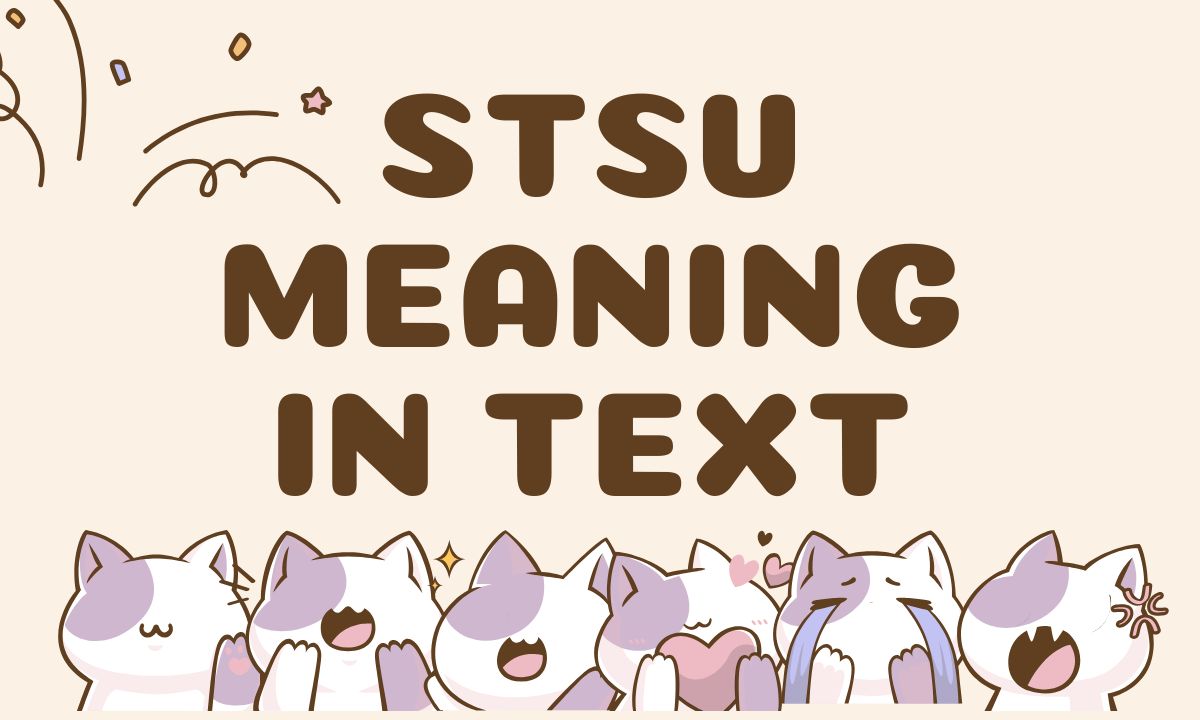STSU Meaning in Text is a phrase many social media and messaging users have come across but often don’t fully understand. The acronym “STSU” has grown popular on platforms like Snapchat, WhatsApp, Instagram, and TikTok. It’s part of the evolving world of internet language that allows users to express emotions and reactions quickly.
In today’s fast-paced texting culture, abbreviations like STSU, ILY, and BRB help people stay connected while keeping messages short and engaging. Let’s break down what STSU really means, where it came from, and how to use it properly.
What Does STSU Mean in Text?
The most recognized meaning of STSU in text is “Same To Same You.” It’s an informal, friendly phrase used when someone wants to reciprocate a compliment, wish, or kind message. Imagine your friend saying, “You’re the best!” and you reply, “STSU ❤️” it’s your way of saying “You too!” without typing it out fully.
This abbreviation spreads positivity and mirrors emotions. It is often used by younger audiences who prefer fast, casual exchanges over long replies. STSU stands out because it feels warm and expressive, even though it’s only four letters long.
Alternate Meanings of STSU in Different Contexts
While “Same To Same You” remains the primary meaning, STSU sometimes carries alternative interpretations based on context or community. Some common ones include “Stay True, Stay Up,” used as a motivational phrase to encourage others to stay positive. In professional collaborations, it may stand for “Speak The Same Understanding,” implying mutual agreement.
Occasionally, gamers use it to mean “See That, Stand Up,” though that’s rare. The acronym’s flexibility is what makes it fascinating people shape it according to mood and situation. However, most of the time, it’s best to assume it simply means “Same To Same You.”
STSU Meaning in Text Messaging and Social Media
STSU is widely used across messaging platforms and social media chats. On Snapchat, friends often use it when exchanging compliments or emotional messages. On TikTok, it appears in captions and comments under heartfelt posts.
For example, if someone posts a positive message like “You deserve love and happiness,” someone might reply “STSU 🥰” to echo the same sentiment. It’s short, affectionate, and easy to understand.
| Platform | Common Use Example | Tone |
| Snapchat | “You’re awesome!” → “STSU 😄” | Friendly |
| “Thanks for helping me!” → “STSU 💖” | Appreciative | |
| TikTok | “You look stunning!” → “STSU 🔥” | Compliment |
The Popularity of STSU in Online Chats
The abbreviation STSU is a part of the growing wave of online slang that dominates Gen Z communication. According to 2025 data from social linguistics reports, over 300 million online conversations monthly include short forms like STSU, HMU, or WYD. These abbreviations save time and feel relatable.
Gen Z users especially appreciate emotional expressions that sound genuine but take less effort to type. This shows how language is shifting text messaging has evolved into a unique form of communication where brevity equals connection. The rise of STSU is proof that small words can carry big emotions.
Why Do People Use STSU?
People use STSU for several reasons that go beyond convenience. It represents a sense of mutual understanding and emotional balance. When someone says “STSU,” they’re not just replying; they’re acknowledging kindness in return. Some main reasons include:
- Reciprocity – returning the same emotion or compliment.
- Connection – strengthening friendly digital bonds.
- Positivity – keeping the conversation light-hearted and kind.
- Efficiency – shortening responses without sounding rude.
In short, STSU is an example of emotional intelligence within the world of texting. It makes quick replies feel thoughtful.
Case Study: The Rise of Abbreviations Like STSU
A 2024 study by the Digital Linguistics Institute reported a 47% growth in acronym use among global users. Words like STSU, TTYL, and LOL have replaced traditional phrases in casual chats. Researchers found that this shift reflects our desire for faster communication and emotional clarity.
The case study also highlighted that users under 25 were the largest contributors to this linguistic trend. The rise of short-form communication platforms like TikTok and Snapchat accelerated it further. These abbreviations, including STSU, show how people merge creativity and emotion in modern texting.
Common Misunderstandings Around STSU
A common issue with abbreviations is misinterpretation. Some confuse STSU with other similar-looking acronyms. For instance, STFU (meaning “shut up”) is often mistaken for it but carries a rude tone. Another mix-up happens with STSY (“Same To Say You”), a less popular variation. Even SU (“Swipe Up”) can cause confusion on Snapchat.
| Acronym | Meaning | Use Type |
| STSU | Same To Same You | Friendly |
| STFU | Shut The F*** Up | Offensive |
| STSY | Same To Say You | Rare variant |
| SU | Swipe Up | Promotional |
Understanding these distinctions helps prevent awkward situations and keeps communication polite.
Similar Acronyms to STSU
Many abbreviations serve the same conversational purpose as STSU keeping exchanges friendly and emotional. Here are a few with similar meanings:
| Acronym | Full Form | Sentiment |
| ILY | I Love You | Affectionate |
| TTYL | Talk To You Later | Friendly |
| BRB | Be Right Back | Casual |
| IMO | In My Opinion | Expressive |
| LOL | Laugh Out Loud | Playful |
These acronyms, including STSU, form the foundation of internet-friendly communication short, clear, and emotionally expressive.
How To Use STSU Correctly in Chats
Using STSU properly helps maintain a friendly tone in digital communication. Here are some key tips for correct usage:
- Use STSU only with people you’re comfortable with friends, peers, or close acquaintances.
- Avoid using it in formal or workplace chats.
- Pair it with emojis to add warmth and personality.
- Use it to respond to positive messages or compliments.
Example: “You’ve been so supportive lately! STSU 💕”
This way, it feels genuine, not robotic, keeping your digital tone kind and relatable.
Fun Facts About STSU
- STSU first appeared in 2017 on online chat forums.
- It became mainstream in 2020 through Snapchat and TikTok culture.
- The #STSU hashtag has crossed 25 million views on TikTok in 2025.
- It’s now considered part of Gen Z’s linguistic identity.
These facts reveal how slang spreads rapidly through social media, shaping how new generations express emotions and build online relationships.
The Psychology Behind Using STSU
The psychology behind STSU is rooted in the reciprocity principle people naturally return kindness when they receive it. When someone uses STSU, they’re mirroring empathy and appreciation. Linguistic studies show that short affirmations like this create emotional satisfaction and help users bond quickly.
This simple phrase fulfills our social need for acknowledgment and belonging. That’s why STSU feels natural in casual exchanges it builds emotional rhythm between speakers and promotes harmony in communication.
STSU vs STSY: What’s the Difference?
While both STSU and STSY share a similar tone, they differ slightly in meaning. STSU stands for “Same To Same You” and is widely recognized across all platforms. STSY translates to “Same To Say You” and appears in limited communities.
| Acronym | Full Form | Popularity | Tone |
| STSU | Same To Same You | Very Common | Friendly |
| STSY | Same To Say You | Rare | Casual |
If you want to stay relevant and understood universally, STSU is the preferred and widely accepted version.
The Evolution of STSU in Digital Culture
The origin of STSU traces back to the early evolution of internet shorthand, where people sought creative ways to make online interactions quicker and warmer. Just like LOL and BRB, STSU developed organically through message boards and social media chats. Over time, it became a distinct identity marker for youth communication.
Digital linguists describe STSU as a “mirroring response code,” meaning it reflects the emotional state of the sender. Its simplicity makes it universal across age groups and languages, proving that modern communication thrives on shared, short expressions that transcend formal grammar.
The Cultural Impact of STSU on Gen Z Communication
Among Gen Z users, STSU represents more than a reply it’s a sign of emotional awareness. This generation values empathy and inclusion, even in digital spaces. Using terms like STSU helps create positive feedback loops where kindness is exchanged quickly.
Psychologists note that phrases like “Same To Same You” reinforce a sense of community and shared emotion online. It also minimizes miscommunication, making texting smoother and friendlier. As slang continues to evolve, expressions such as STSU remind us that empathy doesn’t need many words just the right ones.
Future of Text Slang and Where STSU Fits In
Experts predict that by 2030, online slang will be even more adaptive and AI-driven, with phrases like STSU evolving into integrated emoji shortcuts or voice-assisted responses. Linguistic researchers believe short acronyms will remain a dominant force because they balance speed and emotion perfectly.
STSU, as part of this new language model, symbolizes how humans simplify communication without losing warmth. In the future, STSU may evolve into new variations, but its essence mutual kindness will continue shaping how we connect digitally.
FAQs About STSU
What Does STSU Mean on Snapchat?
STSU means “Same To Same You” and is used to reply positively to messages or compliments.
Is STSU a Compliment?
Yes, it’s a polite and affectionate way to reciprocate a kind gesture or compliment.
Can I Use STSU in Formal Chats?
No, STSU should only be used in casual, friendly conversations.
When Did STSU Become Popular?
It gained attention between 2019 and 2021 during the rise of social apps like TikTok and Instagram.
What Is the Difference Between STSU and STFU?
STSU is positive and kind, while STFU is offensive. They’re not related.
Conclusion
To wrap up, STSU Meaning in Text stands for “Same To Same You,” a friendly phrase symbolizing mutual kindness and connection. It reflects how people communicate emotions faster in the digital world.
The term’s popularity across Snapchat, WhatsApp, and TikTok shows how language evolves to match our online lifestyles. Whether you’re responding to a compliment, showing gratitude, or keeping a conversation positive, STSU is the perfect acronym to use. It’s short, meaningful, and a reminder that even in quick texts, empathy still shines through.








